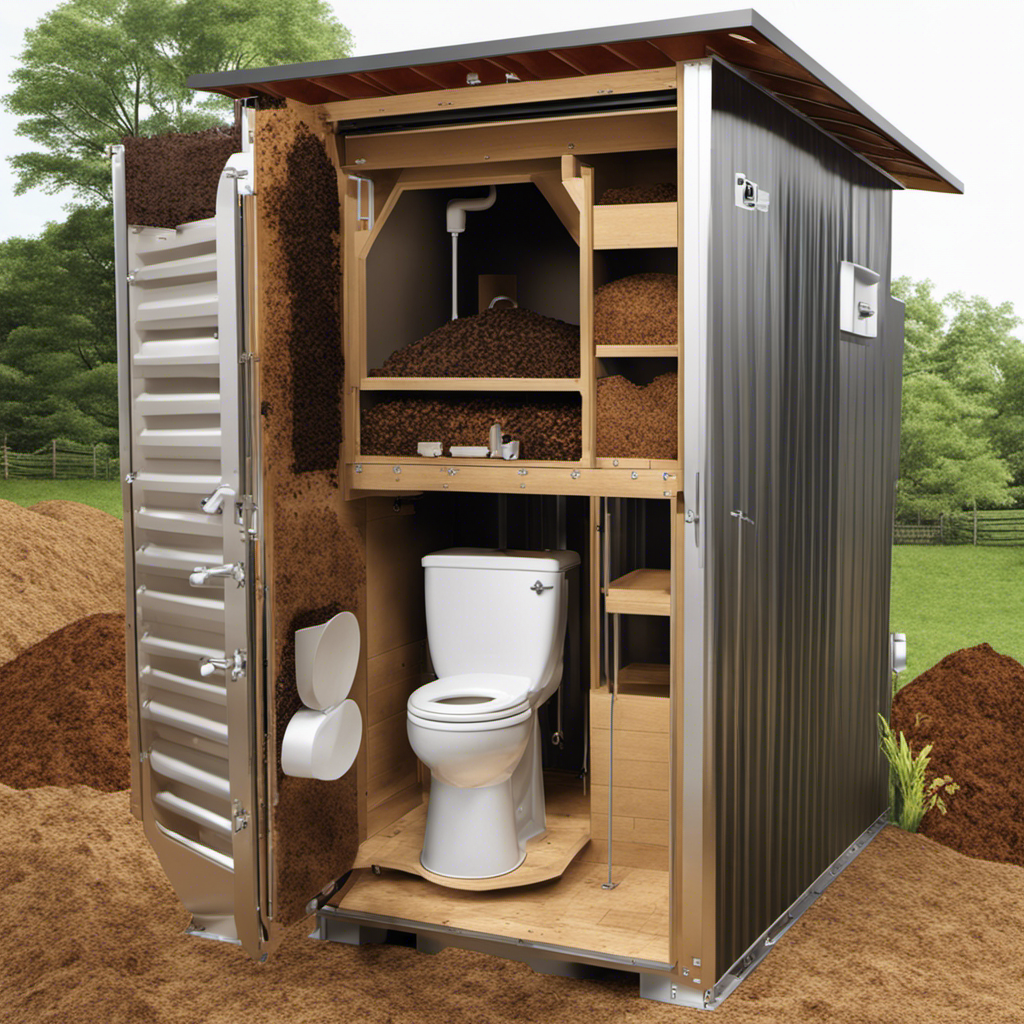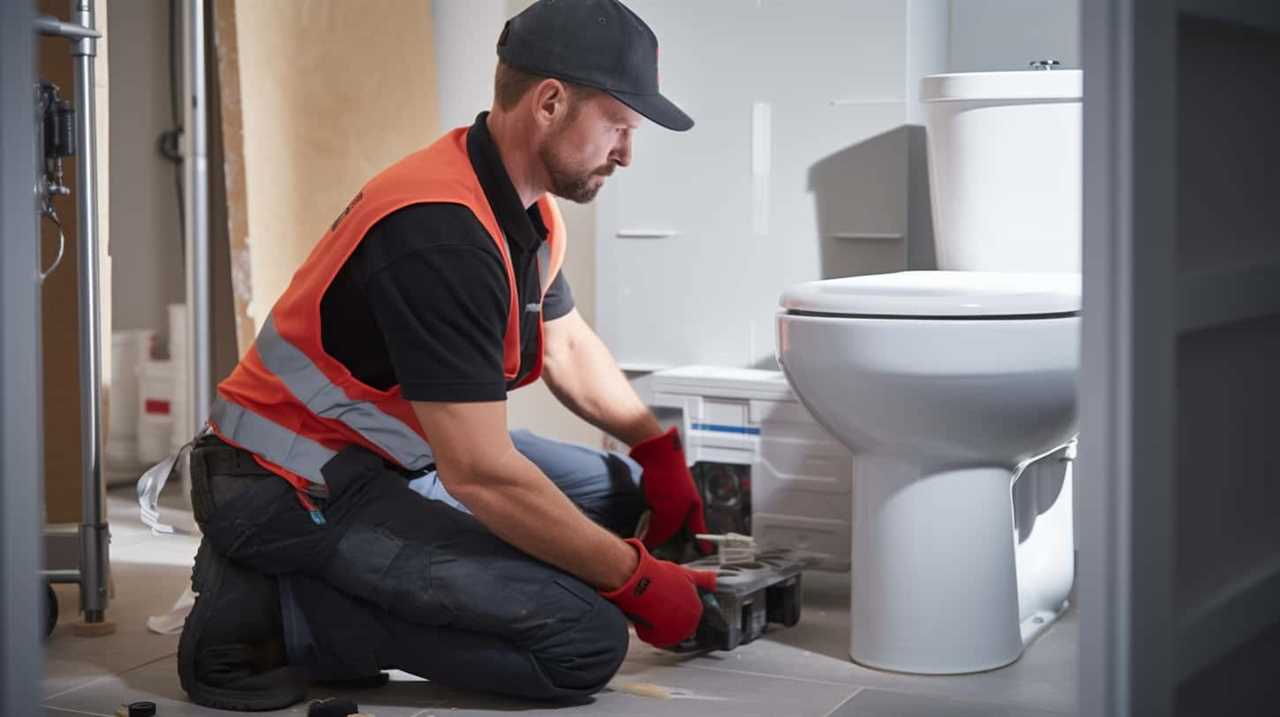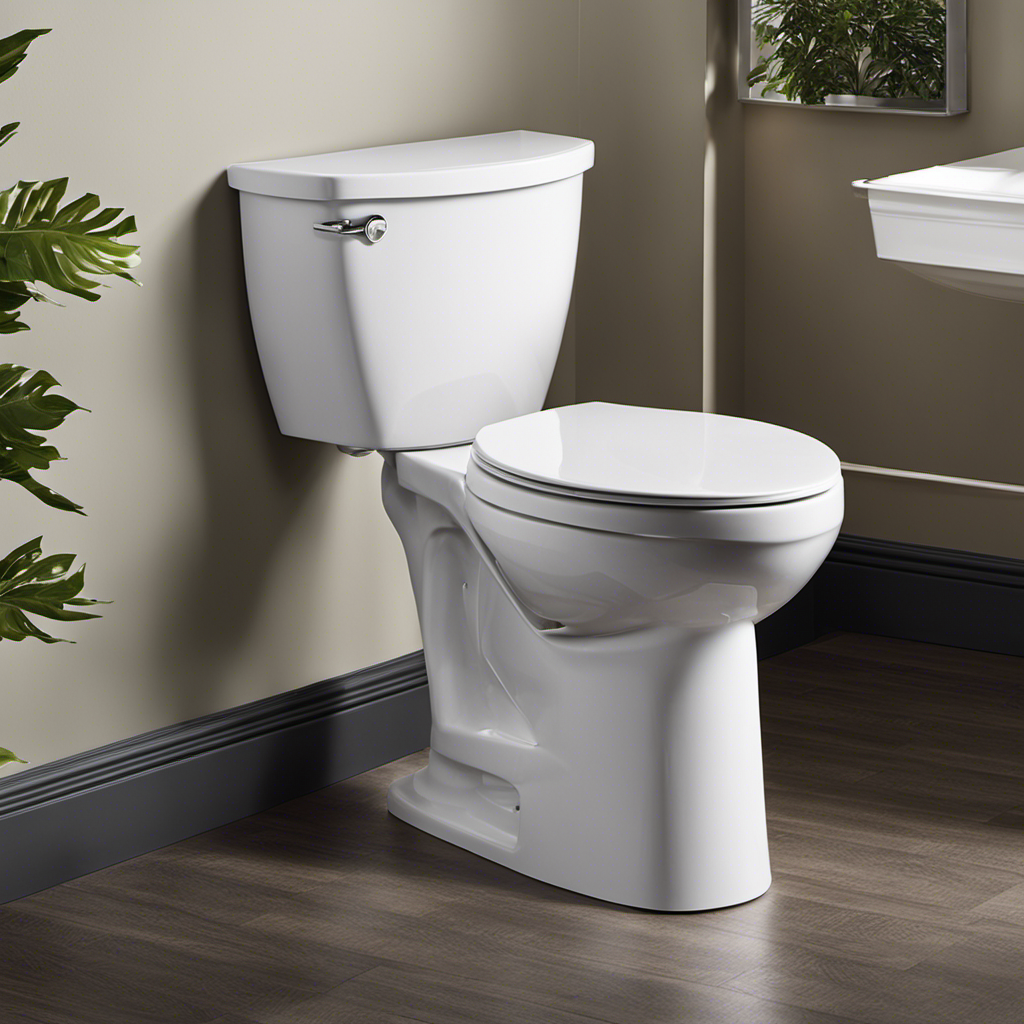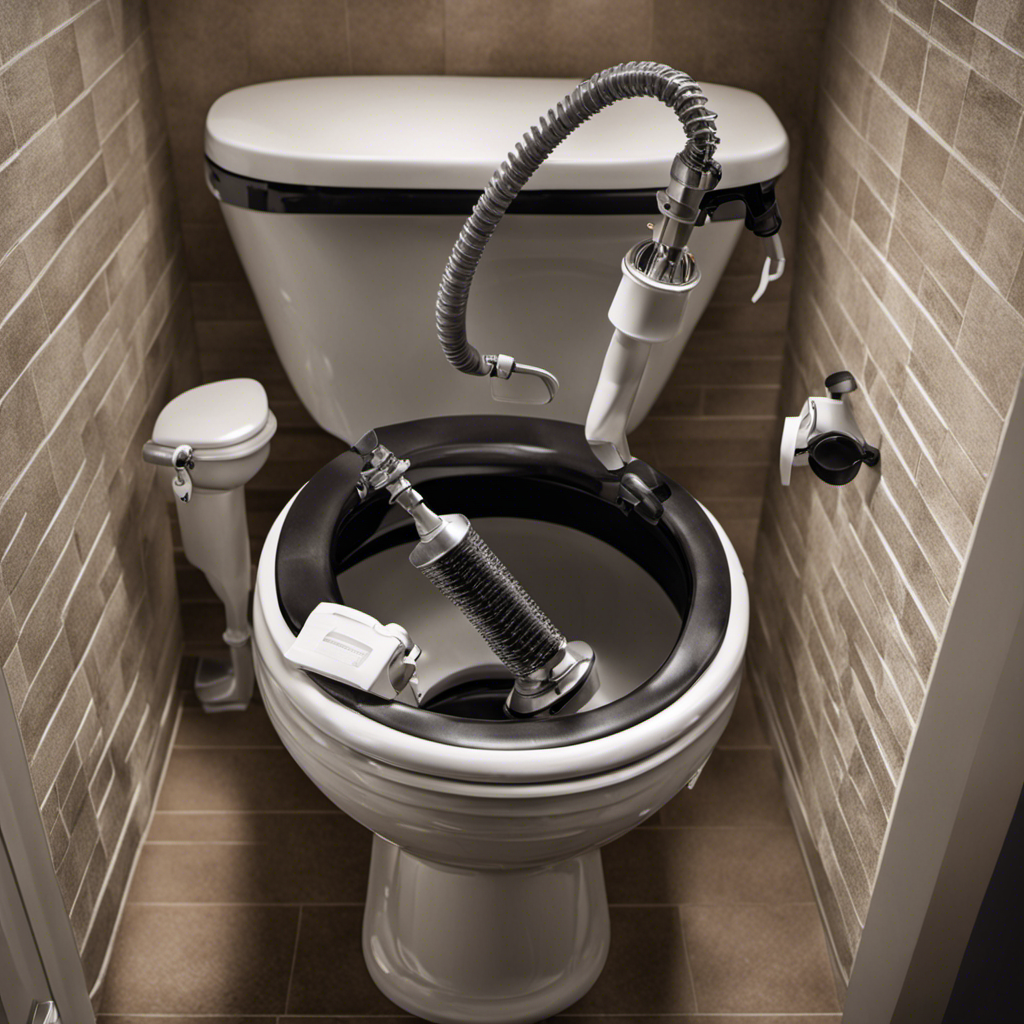Did you know that the average person flushes a toilet about five times a day? That’s a lot of water being wasted! But what if there was a more sustainable solution?
Enter the composting toilet. In this article, I will explain how a composting toilet works, from its components to the process of composting, as well as the advantages and considerations of using one.
So, let’s dive into the world of eco-friendly sanitation and discover the science behind these innovative toilets.
Key Takeaways
- Composting toilets are a sustainable and eco-friendly alternative to traditional flush toilets.
- They reduce water consumption by eliminating the need for flushing.
- Composting toilets have components such as a collection chamber, ventilation system, composting bin, separator, and access door.
- The composting process in a composting toilet involves aerobic decomposition facilitated by bacteria and microorganisms present in the waste, with the help of proper ventilation.
What Is a Composting Toilet
What you need to know about a composting toilet is that it uses natural processes to break down waste into compost. Composting toilets are a sustainable and eco-friendly alternative to traditional flush toilets.
One of the main benefits of a composting toilet is that it reduces water consumption, as it does not require any water for flushing. This makes it an ideal option for areas with limited water supply or for those who want to reduce their water usage.
Additionally, composting toilets are relatively easy to install, requiring minimal plumbing and excavation work. The installation process involves setting up the toilet unit, connecting it to a ventilation system, and providing a suitable composting chamber for the waste to decompose.
Now that we understand what a composting toilet is and its benefits, let’s explore the components of a composting toilet.
The Components of a Composting Toilet
The main components of a composting toilet include a collection chamber, a ventilation system, and a composting bin. These components work together to create a hygienic and sustainable waste management system.
-
Collection chamber: This is where the waste is deposited and stored until it can be composted.
-
Ventilation system: It ensures proper airflow, preventing odor buildup and promoting the aerobic decomposition of waste.
-
Composting bin: This is where the waste is broken down into compost through natural processes.
-
Separator: Some composting toilets have a separator to separate liquid and solid waste, allowing for more efficient composting.
-
Access door: This provides easy access for maintenance and removal of composted material.
Composting toilets offer several benefits, including water conservation, reduced pollution, and the production of nutrient-rich compost. They are also relatively easy to install, making them a viable option for both residential and commercial settings.
With the main components in place, let’s explore the fascinating process of composting in a composting toilet.
The Process of Composting in a Composting Toilet
Once the waste is deposited in the collection chamber, it undergoes aerobic decomposition facilitated by the ventilation system in a composting toilet. The composting process in a composting toilet is a natural and efficient way to break down organic waste into nutrient-rich compost.
The decomposition process is initiated by bacteria and other microorganisms present in the waste. These microorganisms require oxygen to carry out the decomposition process, which is why the ventilation system is crucial in a composting toilet. The ventilation system provides a constant flow of fresh air, ensuring that the waste remains aerobic and preventing any foul odors.
As the waste decomposes, it goes through different stages, from the initial breakdown of organic matter to the final production of compost. The composting process in a composting toilet typically takes several months, depending on factors such as temperature, moisture levels, and the composition of the waste.
Throughout the process, the composting toilet requires minimal maintenance, with periodic turning or stirring of the waste to promote even decomposition. The end result is a nutrient-rich compost that can be safely used as fertilizer for plants, completing the sustainable cycle of waste management in a composting toilet.
Maintaining a Composting Toilet
When it comes to maintaining a composting toilet, there are several key points to consider.
Firstly, odor control methods are crucial in ensuring a pleasant and hygienic environment.
Secondly, proper waste management is essential for the efficient decomposition of waste materials.
Lastly, establishing a regular maintenance routine is vital to keep the composting toilet functioning optimally and to prevent any potential issues from arising.
Odor Control Methods
To control odor in a composting toilet, it’s important to regularly add bulking materials like sawdust or coconut coir. These materials help absorb moisture and provide carbon-rich content, which promotes the breakdown of waste and minimizes odors.
Additionally, there are other natural odor control techniques that can be used in conjunction with the bulking materials. Here are some examples:
- Activated carbon filters: These filters trap odor molecules and prevent them from escaping the toilet system.
- Essential oils: Adding a few drops of essential oils, such as lavender or eucalyptus, can help mask unpleasant odors.
- Baking soda: Sprinkling some baking soda in the toilet can neutralize odors.
- Vinegar: Mixing vinegar with water and spraying it in the toilet can help eliminate odors.
- Ventilation: Proper ventilation is crucial to allow fresh air to circulate and remove any lingering odors.
Proper Waste Management
To properly manage waste in your composting toilet, it’s crucial to follow a few guidelines. Waste disposal methods in composting toilets can have a significant environmental impact. By implementing proper waste management practices, you can minimize pollution and maximize the benefits of composting.
Here are a few key steps to follow:
-
Separate Solid and Liquid Waste: Dividing the waste helps improve the composting process and reduces odor.
-
Add Bulking Material: This material, such as sawdust or coconut coir, helps absorb moisture and promote decomposition.
-
Regularly Empty the Compost Bin: Emptying the bin when it reaches its capacity ensures proper decomposition and prevents overflow.
-
Compost Maturity: Allow the compost to mature for at least six months before using it in your garden. This ensures that any harmful pathogens are eliminated.
Regular Maintenance Routine
Maintaining a regular routine for your composting toilet is essential to ensure its proper functioning and prevent any potential issues. Here are some important steps to keep your composting toilet in top shape:
-
Regular cleaning: Clean the toilet bowl and seat with a mild, biodegradable cleaner to prevent odor and bacteria buildup.
-
Emptying the solids container: Empty the solids container regularly, following the manufacturer’s guidelines. This will ensure proper decomposition and prevent overflow.
-
Monitoring moisture levels: Check the moisture levels in the compost regularly. If it’s too wet, add more bulking material. If it’s too dry, add water.
-
Troubleshooting odor: If you notice any unpleasant odor, check for proper ventilation and adjust as needed. Also, ensure the compost is properly balanced with the right carbon-to-nitrogen ratio.
-
Preventing clogs: Avoid flushing any non-biodegradable items down the toilet to prevent clogs and damage to the composting system.
Advantages of Using a Composting Toilet
One of the advantages of using a composting toilet is that it helps to reduce water consumption. Composting toilets operate by separating liquid and solid waste, allowing the solid waste to decompose naturally over time. This decomposition process results in the production of nutrient-rich compost, which can be used as a natural fertilizer for plants.
By utilizing this process, composting toilets eliminate the need for traditional flushing mechanisms, which can save a significant amount of water. Additionally, composting toilets reduce the strain on septic systems and wastewater treatment facilities, as they do not contribute to the sewage system.
This not only benefits the environment by conserving water resources but also helps to prevent pollution and reduce the energy required for wastewater treatment.
Considerations for Installing a Composting Toilet
When it comes to installing a composting toilet, there are several key points to consider.
Firstly, you need to ensure that you have enough space for the installation of a composting toilet, as it requires a certain amount of room to function properly.
Secondly, proper ventilation and odor control are crucial to maintaining a pleasant environment in your bathroom. Composting toilets can produce odors if not properly managed.
Space Requirements for Installation
To install a composting toilet, you’ll need to consider the space requirements. The installation process involves ensuring that you have enough room for the toilet unit itself, as well as for the necessary ventilation and access for maintenance. Here are some key points to consider:
-
Adequate floor space: The composting toilet will require a designated area in your bathroom or other suitable space.
-
Ventilation space: A ventilation system is essential to remove odors and provide oxygen for the composting process.
-
Access for maintenance: You’ll need to have enough space around the toilet to easily access the composting chamber and remove the finished compost.
-
Plumbing connections: Depending on the type of composting toilet, you may need to consider the location of existing plumbing connections.
-
Clearance from walls and fixtures: It’s important to allow enough clearance around the toilet to ensure proper airflow and ease of use.
Considering these space requirements will help ensure a successful installation of your composting toilet.
Proper Ventilation and Odor Control
Make sure you have adequate ventilation to control odors and provide oxygen for the composting process. Ventilation techniques are crucial in a composting toilet system to maintain a healthy and odor-free environment. Proper airflow helps eliminate odors and promotes the decomposition of waste materials. There are several ventilation options available for composting toilets, including passive and active systems. Passive ventilation relies on natural air movement, while active systems use fans to enhance airflow. Both methods effectively remove odors and prevent the buildup of harmful gases. Additionally, proper vent pipe installation is essential to ensure the expulsion of odorous air outside the building. By implementing these ventilation techniques, you can enjoy an odor-free and efficient composting toilet system.
| Ventilation Techniques | Description | Benefits |
|---|---|---|
| Passive Ventilation | Utilizes natural air movement | Energy-efficient, low maintenance |
| Active Ventilation | Uses fans to enhance airflow | Faster composting, better odor control |
| Vent Pipe Installation | Properly installed pipe expels odorous air outside | Prevents odors from entering the building |
Maintenance and Waste Management
Regular maintenance is crucial for ensuring the proper management of waste in a composting toilet system. To effectively maintain this system, the following steps should be taken:
- Regularly adding composting material to aid in the waste decomposition process.
- Turning or agitating the compost to promote oxygen flow and microbial activity.
- Monitoring and maintaining the moisture levels to ensure a balanced composting process.
- Periodically checking and adjusting the temperature to support optimal decomposition.
- Properly disposing of the fully composted material to make room for new waste.
By following these maintenance practices, the composting toilet system can efficiently break down waste through the composting process. This process relies on the action of bacteria, fungi, and other microorganisms that decompose the waste materials, transforming them into nutrient-rich compost.
Regular maintenance not only facilitates waste decomposition but also contributes to the overall functionality and sustainability of the composting toilet system.
Common Misconceptions About Composting Toilets
Did you know that composting toilets do not smell bad if they’re properly maintained?
There are many misconceptions about composting toilets, but the truth is that when used correctly, they are odorless and hygienic.
One common misconception is that composting toilets are unsanitary and unclean. However, composting toilets are designed to break down waste into compost through natural processes such as decomposition and evaporation.
These toilets use a system of aerobic bacteria and other microorganisms to convert human waste into nutrient-rich compost, which can be safely used as fertilizer.
In addition to being environmentally friendly, composting toilets also have other benefits. They conserve water by not requiring any flushing, and they can be used in remote areas without access to traditional sewage systems.
Frequently Asked Questions
Are Composting Toilets Legal in All Areas?
Composting toilets’ legality varies depending on local legal regulations. They are allowed in many areas due to their environmental benefits, such as reducing water usage and producing nutrient-rich compost.
How Often Do You Need to Empty a Composting Toilet?
I empty my composting toilet every few months, depending on usage. It’s a low-maintenance option that offers numerous benefits, such as reducing water consumption and producing nutrient-rich compost for gardening.
Can a Composting Toilet Produce Harmful Odors?
Yes, a composting toilet can produce harmful odors if not properly maintained. Regular maintenance, such as emptying the compost bin and adding bulking agents, helps prevent the build-up of harmful chemicals and control odors.
What Type of Waste Can Be Composted in a Composting Toilet?
Composting toilets can process biodegradable waste like human waste, toilet paper, and organic matter. It’s beneficial as it reduces water usage, prevents pollution, and produces nutrient-rich compost. Maintenance involves adding bulking agents and ensuring proper ventilation.
Can a Composting Toilet Be Used in Cold Climates?
In cold climates, composting toilets have benefits and limitations. They can work effectively with proper insulation and ventilation. However, extreme temperatures may slow down the composting process. Regular maintenance and monitoring are necessary.
Conclusion
In conclusion, composting toilets are a viable and sustainable solution for managing human waste.
By utilizing natural processes of decomposition and turning waste into nutrient-rich compost, these toilets offer a cleaner and more environmentally friendly alternative to traditional flush toilets.
They are low-maintenance and can be easily installed in various settings.
Composting toilets not only reduce water usage, but also contribute to soil fertility and promote a circular economy.
So, if you’re looking for a greener way to handle your waste, consider the benefits of a composting toilet.










